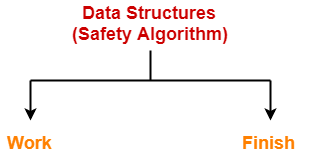Deadlock Avoidance-
Before you go through this article, make sure that you have gone through the previous article on Deadlock and Handling Strategies.
We have discussed-
- In a deadlock state, the execution of multiple processes is blocked.
- Deadlock avoidance strategy involves maintaining a set of data.
- The data is used to make a decision whether to entertain any new request or not.
- If entertaining the new request causes the system to move in an unsafe state, then it is discarded.
Banker’s Algorithm-
- Banker’s Algorithm is a deadlock avoidance strategy.
- It is called so because it is used in banking systems to decide whether a loan can be granted or not.
Prerequisite-
Banker’s Algorithm requires-
- Whenever a new process is created, it specifies the maximum number of instances of each resource type that it exactly needs.
Data Structures Used-
To implement banker’s algorithm, following four data structures are used-

- Available
- Max
- Allocation
- Need
| Data Structure | Definition | Example |
| Available | It is a single dimensional array that specifies the number of instances of each resource type currently available. | Available[R1] = K
It means K instances of resource type R1 are currently available. |
| Max | It is a two dimensional array that specifies the maximum number of instances of each resource type that a process can request. | Max[P1][R1] = K
It means process P1 is allowed to ask for maximum K instances of resource type R1. |
| Allocation | It is a two dimensional array that specifies the number of instances of each resource type that has been allocated to the process. | Allocation[P1][R1] = K
It means K instances of resource type R1 have been allocated to the process P1.
|
| Need | It is a two dimensional array that specifies the number of instances of each resource type that a process requires for execution. | Need[P1][R1] = K
It means process P1 requires K more instances of resource type R1 for execution. |
Working-
- Banker’s Algorithm is executed whenever any process puts forward the request for allocating the resources.
- It involves the following steps-
Step-01:
- Banker’s Algorithm checks whether the request made by the process is valid or not.
- If the request is invalid, it aborts the request.
- If the request is valid, it follows step-02.
Valid RequestA request is considered valid if and only if- The number of requested instances of each resource type is less than the need declared by the process in the beginning. |
Step-02:
- Banker’s Algorithm checks if the number of requested instances of each resource type is less than the number of available instances of each type.
- If the sufficient number of instances are not available, it asks the process to wait longer.
- If the sufficient number of instances are available, it follows step-03.
Step-03:
- Banker’s Algorithm makes an assumption that the requested resources have been allocated to the process.
- Then, it modifies its data structures accordingly and moves from one state to the other state.
Available = Available - Request(i) Allocation(i) = Allocation(i) + Request(i) Need(i) = Need(i) - Request(i)
- Now, Banker’s Algorithm follows the safety algorithm to check whether the resulting state it has entered in is a safe state or not.
- If it is a safe state, then it allocates the requested resources to the process in actual.
- If it is an unsafe state, then it rollbacks to its previous state and asks the process to wait longer.
Safe StateA system is said to be in safe state when- All the processes can be executed in some arbitrary sequence with the available number of resources. |
Safety Algorithm Data Structures-
To implement safety algorithm, following two data structures are used-

- Work
- Finish
| Data Structure | Definition | Example |
| Work | It is a single dimensional array that specifies the number of instances of each resource type currently available. | Work[R1] = K
It means K instances of resource type R1 are currently available. |
| Finish | It is a single dimensional array that specifies whether the process has finished its execution or not. | Finish[P1] = 0
It means process P1 is still left to execute. |
Safety Algorithm-
Safety Algorithm is executed to check whether the resultant state after allocating the resources is safe or not.
Step-01:
Initially-
- Number of instances of each resource type currently available = Available
- All the processes are to be executed.
- So, in Step-01, the data structures are initialized as-
Work = Available Finish(i) = False for i = 0, 1, 2, ..., n-1
Step-02:
- Safety Algorithm looks for an unfinished process whose need is less than or equal to work.
- So, Step-02 finds an index i such that-
Finish[ i ] = False Need(i) <= Work.
- If such a process exists, then step-03 is followed otherwise step-05 is followed.
Step-03:
- After finding the required process, safety algorithm assumes that the requested resources are allocated to the process.
- The process runs, finishes its execution and the resources allocated to it gets free.
- The resources are then added to the work and finish(i) of that process is set as true.
Work = Work + Allocation Finish(i) = True
Step-04:
- The loop of Step-02 and Step-03 is repeated.
Step-05:
- If all the processes can be executed in some sequence, then the system is said to be in a safe state.
- In other words, if Finish(i) becomes True for all i, then the system is in a safe state otherwise not.
To gain better understanding about Banker’s Algorithm,
Next Article- Practice Problems On Banker’s Algorithm
Get more notes and other study material of Operating System.
Watch video lectures by visiting our YouTube channel LearnVidFun.

